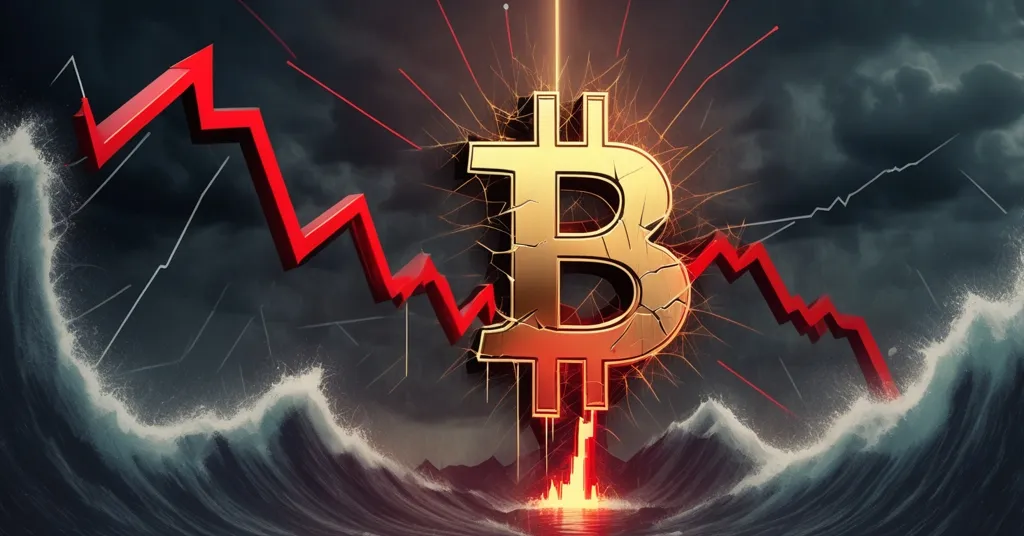Bitcoin Crash: NVT Golden Cross Signals Undervaluation Amid 35% Drop to $86K

Bitcoin’s Brutal Crash: NVT Golden Cross Hints at Undervaluation Amid Market Chaos
Bitcoin has been hammered hard, losing over 35% of its value since early October, crashing from a dizzying high of $126,000 to a fragile $86,000. While panic grips the market and analysts rush to declare a bear market, an obscure on-chain metric—the Bitcoin NVT Golden Cross—is flashing a signal that suggests BTC might be undervalued, potentially offering a contrarian opportunity for the brave. But with volatility spiking and fear everywhere, is this a real chance or just a trap?
- Price Collapse: Bitcoin drops 35% from $126,000 to $86,000, briefly falling below $85,000.
- NVT Signal: Golden Cross nears –1.6, a historical marker of undervaluation and potential rallies.
- Danger Zone: Thin liquidity, high volatility, and systemic fear keep risks sky-high.
The Bitcoin Bloodbath: Unpacking the 35% Drop
Let’s not mince words: Bitcoin’s recent plunge has been nothing short of savage. Since hitting its peak at $126,000 in early October, BTC has shed over a third of its value, bottoming out around $86,000 with a brief slip below $85,000. This isn’t some gentle pullback—high trading volumes during the decline scream aggressive selling and outright capitulation. We’re talking about investors dumping positions in a frenzy, not a slow bleed caused by low activity. The numbers paint a grim picture, and the sentiment is even worse.
Many market watchers are already sounding the alarm, labeling this the start of a full-on bear market. They point to structural breakdowns in Bitcoin’s price action and a clear rejection at cycle highs as proof that the bull run is dead. Social media is ablaze with doom-laden posts, and even seasoned traders are questioning whether the momentum that drove BTC to six figures can ever return. With macroeconomic pressures—like potential interest rate hikes and persistent inflation fears—adding fuel to the fire, it’s easy to see why pessimism reigns supreme across risk assets, not just crypto.
NVT Golden Cross: A Flicker of Hope?
Yet, amidst this widespread despair, a quieter signal is emerging from on-chain data, offering a counterpoint to the panic. The Bitcoin NVT Golden Cross, an indicator that measures the relationship between Bitcoin’s market value and the actual usage on its network, is approaching a critical threshold of –1.6. According to on-chain analysts, when this metric dips below that level, it often signals that BTC’s price is too low compared to its real-world activity—a classic sign of undervaluation. Historically, such readings have preceded significant recovery rallies, giving contrarian investors a reason to pause before joining the mass exodus. For more on this intriguing signal, check out this detailed analysis of Bitcoin’s undervaluation signal.
For those less familiar with the jargon, let’s break it down. NVT stands for Network Value to Transactions, and it’s akin to a price-to-earnings ratio for traditional stocks. It compares Bitcoin’s total market cap (its “value”) to the volume of transactions happening on the blockchain (how much it’s being used). A high NVT suggests the price is inflated relative to usage, while a low NVT hints that the price might be a bargain. The “Golden Cross” is a refined version of this metric, smoothing out short-term noise to highlight major turning points. Back in 2018, for instance, when the NVT Golden Cross hit similar lows after a brutal crash, Bitcoin rallied nearly 40% in the following two months. A similar pattern played out during the 2021 mid-cycle correction, with a 25% bounce within weeks. Could history repeat itself?
Before we get carried away, though, let’s ground this hope in reality. While the NVT signal has a decent track record, it’s not a crystal ball. Past performance doesn’t guarantee future results, especially in a market as unpredictable as crypto. The data gives us a clue, not a certainty, and timing a bottom based on any single indicator is like trying to catch a falling knife—possible, but bloody painful if you miss.
Market Risks: Why Caution Remains Paramount
Even if the NVT Golden Cross is screaming “buy,” the broader market conditions are screaming “run for the hills.” Liquidity in the crypto space right now is thinner than a dollar-store napkin, meaning even small trades can trigger massive price swings. Volatility is off the charts, with daily fluctuations that can wipe out leveraged positions in hours. Add to that a pervasive sense of systemic fear—not just in Bitcoin, but across all speculative assets like stocks and altcoins—and you’ve got a recipe for chaos.
This fear isn’t coming from nowhere. Broader financial markets are grappling with uncertainty, from stubbornly high inflation to central banks hinting at tighter monetary policies. Geopolitical tensions and supply chain disruptions aren’t helping either, as they spook investors away from anything perceived as risky. Bitcoin, despite its decentralized ethos, isn’t immune to these macro headwinds. When the world feels like it’s on edge, capital flees to safe havens like gold or government bonds, leaving assets like BTC exposed to heavy selling pressure. On-chain analysts caution that in such disorderly price action, even trusted signals like the NVT can lose their edge. Betting big right now, especially with leverage, is a gamble that could burn even the savviest traders.
Technical Levels: Bitcoin’s Battleground
Zooming in on Bitcoin’s price chart, the situation looks like a war zone. The price has sliced through key short-term trendlines, dropping below both the 50-day and 100-day moving averages. For the uninitiated, these are average prices over those timeframes, often used by traders to gauge whether a trend is bullish or bearish. When the price falls below them, as it has now, they turn from support into resistance—brick walls that BTC must climb over to regain momentum. Right now, they’re acting as barriers, capping any quick recovery attempts.
The real line in the sand, though, is the 200-day moving average, currently sitting at around $88,000. This longer-term trendline is a critical benchmark; it often separates a temporary dip from a deeper downtrend. If Bitcoin closes below this level on a daily basis, it could trigger a cascade of further selling, potentially dragging the price down to $78,000 or $80,000—a zone that’s both a psychological floor and a historical support level. Conversely, if buyers can push BTC back above $90,000, it might break the bearish pattern of lower highs and lower lows, giving bulls a fighting chance. Until that happens, the technical outlook remains ugly, and the bears hold the upper hand.
Broader Impact: Altcoins and Institutional Moves
Bitcoin’s woes aren’t happening in a vacuum—they’re rippling across the entire crypto ecosystem. Altcoins, those other cryptocurrencies beyond BTC, are often hit even harder during downturns like this. Many have seen losses of 40-50% or more, as capital rotates out of riskier assets into stablecoins or even out of crypto entirely. Ethereum, for instance, has mirrored Bitcoin’s decline but with sharper drops on some days, reflecting its higher beta (a fancy term for being more volatile than the market leader). This correlation shows how interconnected the space remains, despite narratives of altcoins carving out unique niches.
Meanwhile, institutional behavior is adding to the downward pressure. Take MARA, a prominent Bitcoin mining company, which recently offloaded 644 BTC in a single transaction, transferring $58.7 million worth to platforms like FalconX and Coinbase Prime. Why are miners selling? Often, it’s to cover operational costs—think electricity bills and debt payments—especially when prices tank and mining profitability shrinks. This isn’t new behavior, but it stings more in a fragile market where retail confidence is already shaken. Unlike past cycles where miners held firm during dips, expecting quick recoveries, the current uncertainty seems to be pushing蒯
some to liquidate. It’s a stark reminder that even undervaluation signals don’t stop big players from dictating short-term pain.
Bitcoin’s Bigger Picture: Volatility vs. Vision
Let’s step back and confront an uncomfortable question: does this kind of gut-wrenching volatility undermine Bitcoin’s claim as a “store of value”? Critics—especially those cozy with traditional finance—love to pounce on crashes like this, arguing that something with 35% swings can’t be a reliable hedge against inflation or a safe haven. And honestly, they’ve got a point in the short term. When your portfolio can evaporate by a third in weeks, it’s hard to preach stability to the unconverted.
But here’s the counterpunch: Bitcoin’s long-term vision isn’t about day-to-day price stability—it’s about dismantling centralized control and offering financial sovereignty. Crashes are brutal, sure, but they’re also a stress test for the network and its believers. Each cycle shakes out over-leveraged speculators and weak hands, leaving behind those with real conviction. Adoption trends tell a more optimistic story—look at the Lightning Network’s growth for faster, cheaper transactions, or nation-states like El Salvador embracing BTC as legal tender. These are signs that the rebellion against fiat systems is alive, even if the price chart looks like a horror movie right now. Volatility is the price of disrupting the status quo, and for Bitcoin maximalists like myself, it’s a price worth paying.
That said, I’m not here to peddle blind faith. The risks are real, and anyone pretending otherwise is either clueless or grifting. Ignore the YouTube clowns predicting $200K by next month—the same folks who swore we’d hit $10K last week. Focus on the data, not the hype. Bitcoin’s potential to redefine money doesn’t mean it’s immune to market cycles or macro shocks. The question is whether you believe in the endgame enough to weather the storm.
Key Takeaways and Burning Questions
- What does Bitcoin’s 35% crash since October signal for its future?
It points to heavy capitulation and bearish sentiment, potentially marking a deeper downtrend. Yet, on-chain metrics like the NVT Golden Cross suggest BTC might be undervalued, hinting at a possible rebound if key support levels hold. - How reliable is the NVT Golden Cross as a buying opportunity now?
It has a solid historical track record, with past rallies following similar readings, but current market chaos—thin liquidity and extreme volatility—makes it a risky signal to act on without caution. - Why are moving averages critical for Bitcoin’s price direction?
They act as trend indicators; the 200-day moving average at $88,000 is a major threshold. A break below could deepen losses, while reclaiming $90,000 might shift momentum back to the bulls. - How does systemic fear in global markets affect Bitcoin?
As a risk asset, Bitcoin suffers when investors flee to safer options during economic uncertainty. Macro factors like inflation or rate hikes amplify selling pressure, regardless of on-chain signals. - Is this crash the start of a bear market or a temporary correction?
It’s too early to call. Technical breakdowns lean toward a bearish outlook, but undervaluation signals and historical patterns suggest this could be a painful shakeout before a relief rally.
Keep your focus on that $88,000 level—it’s the pivot point that could define Bitcoin’s path into year-end. Don’t fall for leverage traps or empty promises of instant riches. Bitcoin’s history is full of vicious drops followed by stunning recoveries, but it’s also littered with the ashes of those who tried to time the market. If you’re in for the long haul, stack sats with conviction. If not, brace for more turbulence. Either way, the fight for decentralized finance doesn’t pause for a 35% stumble—it just gets louder.



